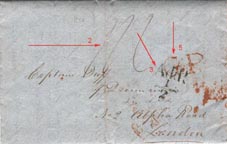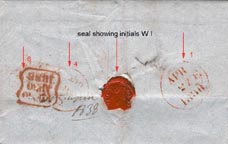Eunice and Ron Shanahan have shared with readers of the Victorian Web this material from their website, Letters from the Past. Click on thumbnails for larger images.
This letter was written by William Innes, a Writer to the Signet (a Scottish solicitor) in Edinburgh to his client Capt Duff. The address on the front of the letter looks like Capt Duff of Drummoin &c &c No.2 Alpha Street London.
Note: the '&c &c' meaning 'etc, etc' was the form used when the writer could not be bothered to write all the titles that should have appeared after Capt. Duff's name but one of the postmarks has been struck right across the surname, so I cannot be sure of that. As is usual with these old letters, it has been sealed with a blob of sealing wax, in this case with the impression of a signet ring with the initials W.I. for William Innes.
Postal Markings

The six postal markings are all unusually clear. Three - on the front of the cover - were struck at the beginning of the journey:
- circular date stamp applied in Edinburgh APR 27 E 1838
- Manuscript charge mark of 1/1 (one shilling and one penny) for a distance between 300 and 400 miles 1812-1839 - Edinburgh to London was 396 miles
- Additional 1/2d Scottish mail tax applied in Edinburgh type 2a in use from 5 September 1827 to 24 May 1839, identifiable by the size, which is 19mm x 16mm.

The other three applied at the London end, all in red ink:
- London arrival date stamp 29 APR 1838 S signifying Sunday- in use 1812-1842
- G:P. General Post stamp applied when the 1 penny fee for the Penny Post had not been paid, this type with a semicolon between the letters and a full stop at the base of the letter P was in use 1837-1839
- Transfer date stamp applied at the City Office of the London Twopenny Post Office showing 10 Fn APR 30 1838. The City Office date stamps always showed the month before the day. This type of indented stamp was in use from1838 until 1842.
The Letter
The letter is a clearly legible example of information and straightforward instructions.
April 27th 1838,
My Dear Sir,
I have been duly favoured with your letters of the 24th and 25th, the last by the post of today.
I called for Mr Fraser on the receipt of the first but was informed that he had gone out of town and will not be back for a week or so. Whether he had got your letter or not, or had construed it as setting them at defiance once for all, I cannot tell, but I had no communication from him. In consequence I think it right to send you annexed a copy of what I wrote him, in answer to his letter of the 21st.
You will see on referring to that letter that he expressed himself willing to communicate unreservedly the Memorials and Opinions provided he had an assurance of your willingness to be convinced by these authorities of the justice of dividing the moneys with them - an assurance which you or no man in his senses could give, without first seeing them. What I intended to do if I had found him at home was to put your letter of the 24th into his hand to read, and I think I will still do so when I see him, as I cannot convey to him your sentiments in any way so well.
Meanwhile I think it would be advisable for you now, to write to Mr Gondonin for a certified copy of the entire Deed and not the preamble of it, of 25 May 1831, conveying Richelony and also an Office Extract, complete, of the whole proceedings of the Court recognizing your right to the moveable property in France and adjudging it to you accordingly.
These will certainly be required if any legal proceedings are to take place here, and even if they should be the means of averting such, or aid in this, the expenses of obtaining them will be well bestowed.
M. De la Grange too, prefaces his Opinion with saying he has read a ‘Note’ presented for your for consideration, this Note then, being I presume, another name for what we call a Memorial, it will be indispensably necessary to have a copy of it - there is nothing further occurs to me at present
I Remain
Your most truly
William Innes”
Then on the inside of the sheet William Innes has copied his earlier letter. In it he explains the reason for the delay, showing how hard the Post Office had tried to deliver that letter. It had been to the Isle of Wight (in the English Channel), back up to Scotland, and then back down to London.
“Copy letter Mr William Innes W.S. to Hugh Fraser Esq W.S.
Edinburgh 21st April 1838.
Dear Sir
I am just favoured with your Letter of today of which I am in course of forwarding a copy to Captain Duff. I did not understand that you was to expect to hear from us, in answer to your Letter of the 28th Ultimo, till you made a communication of the Opinion to be obtained in France; but, independent of that, the Packet, which I forwarded to Captain Duff containing copies of that letter and the accompanying papers had missed him at the Isle of Wight, and after some wandering found its way to Elgin, from whence it came back here, and was again sent on to him to London, where I expect that it would still reach him. I can say nothing more at present, therefore till I hear from him.
I remain &c.”
Questions
Since the letter is more than 160 years old, it is proving difficult to answer the queries that spring to mind. For instance,
- who was Capt. Duff?
- was he a naval or a military Captain?
- what was he doing in the Isle of Wight in 1838?
- I wonder what was the property in France, (Richelony?) and
- what was the outcome of this disagreement?
A search through my various reference books and on the internet has not produced any clues at this stage. However with the phenomenal growth of the internet community and the increasing amount of information becoming available, I may find out. I have learned that Alpha Street still exists in the London suburb of Peckham Rye, so you just never know.
Bibliography
Hodgson & Sedgwick Scottish Additional Halfpenny Mail Tax.
Robertson, Alan W. Great Britain Post Roads Post Towns and Postal Rates 1635-1839.
Brumell, George. The Local Posts of London 1680-1840.
Last modified 14 February 2005